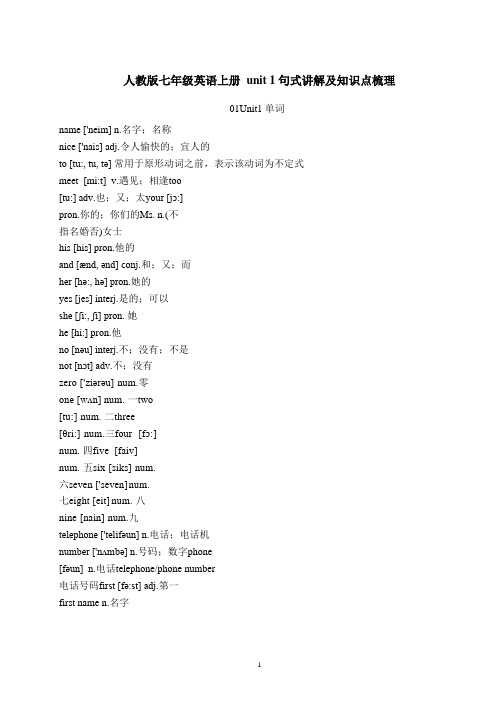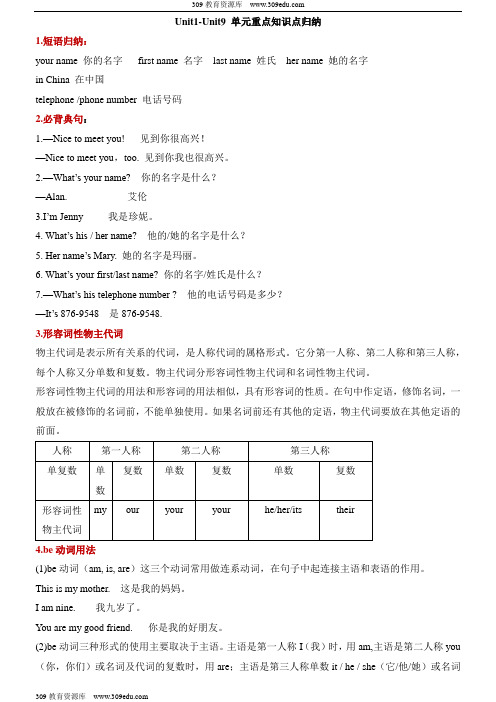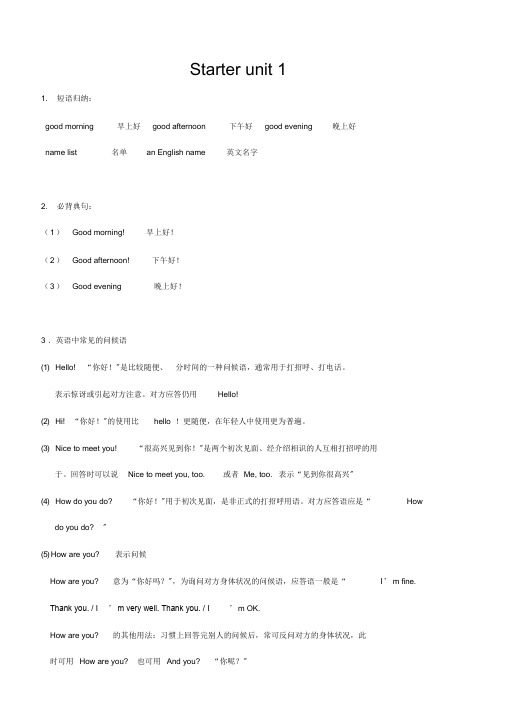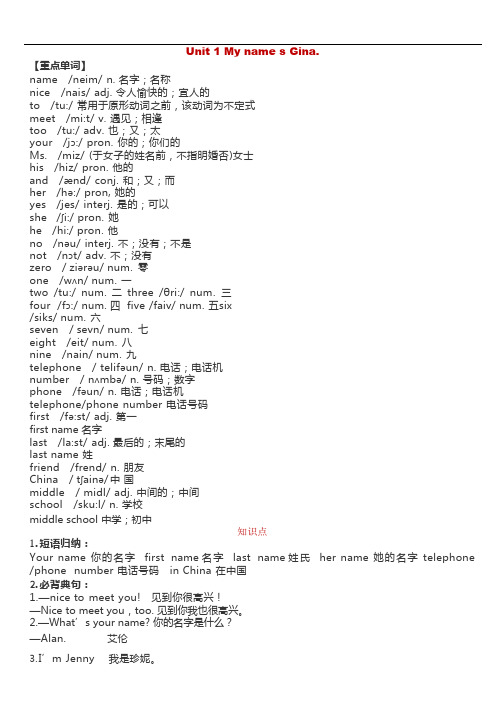人教版七年级上册英语Unit1知识点总结
人教版初一英语七年级上册Unit 1知识点

人教版初一英语七年级上册Unit 1知识点Unit 1 My name's Gina.【重点单词】name /neim/ n. 名字;名称nice /nais/ adj. 令人愉快的;宜人的to /tu:/ 常用于原形动词之前,该动词为不定式meet /mi:t/ v. 遇见;相逢too /tu:/ adv. 也;又;太your /jɔ:/ pron. 你的;你们的Ms. /miz/ (于女子的姓名前,不指明婚否)女士his /hiz/ pron. 他的and /ænd/ conj. 和;又;而her /hə:/ pron, 她的yes /jes/ interj. 是的;可以she /ʃi:/ pron. 她he /hi:/ pron. 他no /nəu/ interj. 不;没有;不是not /nɔt/ adv. 不;没有zero /'ziərəu/ num. 零one /wʌn/ num. 一two /tu:/ num. 二three /θri:/ num. 三four /fɔ:/ num. 四five /faiv/ num. 五six /siks/ num. 六seven /'sevn/ num. 七eight /eit/ num. 八nine /nain/ num. 九telephone /'telifəun/ n. 电话;电话机number /'nʌmbə/ n. 号码;数字phone /fəun/ n. 电话;电话机telephone/phone number 电话号码first /fə:st/ adj. 第一first name 名字last /la:st/ adj. 最后的;末尾的last name 姓friend /frend/ n. 朋友China /'tʃainə/ 中国middle /'midl/ adj. 中间的;中间school /sku:l/ n. 学校middle school 中学;初中知识点:1.短语归纳:Your name 你的名字first name 名字last name 姓氏her name 她的名字telephone /phone number 电话号码in China 在中国2.必背典句:1.—nice to meet you! 见到你很高兴!—Nice to meet you,too. 见到你我也很高兴。
人教版七年级英语上册 unit 1 句式讲解及知识点梳理

人教版七年级英语上册unit 1 句式讲解及知识点梳理01Unit1 单词name ['neim] n.名字;名称nice ['nais] adj.令人愉快的;宜人的to [tu:, tu, tə] 常用于原形动词之前,表示该动词为不定式meet [mi:t] v.遇见;相逢too[tu:] adv.也;又;太your [jɔ:]pron.你的;你们的Ms. n.(不指名婚否)女士his [his] pron.他的and [ænd, ənd] conj.和;又;而her [hə:, hə] pron.她的yes [jes] interj.是的;可以she [ʃi:, ʃi] pron. 她he [hi:] pron.他no [nəu] interj.不;没有;不是not [nɔt] adv.不;没有zero ['ziərəu] num.零one [wʌn] num. 一two[tu:] num. 二three[θri:] num.三four [fɔ:]num. 四five [faiv]num. 五six [siks] num.六seven ['seven] num.七eight [eit] num. 八nine [nain] num.九telephone ['telifəun] n.电话;电话机number ['nʌmbə] n.号码;数字phone[fəun] n.电话telephone/phone number电话号码first [fə:st] adj.第一first name n.名字last [lɑ:st] adj.最后的;末尾的last name 姓friend [frend] n.朋友China ['tʃainə] 中国middle ['midl] adj.中间的n.中间school [sku:l] n.学校middle school 中学;初中Gina 吉娜(女名)Jenny ['dʒeni, 'dʒini] 珍妮(女名)Brown [braun] 布朗(姓)Alan ['ælən] 艾伦(男名)Tom [tɔm] 汤姆(男名)Mike [maik] 迈克(男名)Jack [dʒæk] 杰克(男名)Mary ['mɛəri] 玛丽(女名)Miller ['milə] 米勒(姓)Linda ['lində] 琳达(女名)Jane [dʒein] 简(女名)Green [gri:n] 格林(姓)Smith [smiθ] 史密斯(姓)02Starter Unit1 知识梳理【重点短语】1. my name 我的名字2.your name 你的名字3. her name 她的名字.4. his name 他的名字5. I’m .. . 我是……6. first name 名字7. last name/family name 姓氏8. Ms. Brown 布朗女士9. your school ID card 你的学生卡10. phone/telephone number 电话号码11. his ID card number 他的身份证号码12. my friend 我的朋友13. nice to meet you 很高兴见到你14. middle school 中学15. in China 在中国【重点句型】1. —What’s your name? 你叫什么名字?一I’m /M y name is Alan. 我叫艾伦。
人教版英语七年级上册 Unit1 知识点梳理

人教版英语七年级上册Unit1知识点梳理一、重点短语句子1.Nice to meet you.遇见你很高兴2.first name名字last name=family name姓3.telephone number=phone number电话号码4.middle school中学5.an ID card一张身份证6.Good morning.早上好7.Good afternoon下午好8.Good evening晚上好9.in the morning在上午in the afternoon 在下午in the evening在晚上10.a t night在夜晚at noon在中午11.H ow are you?你好吗?12.H ow’s your day?你今天怎么样?13.t hank you=thanks谢谢你14.I’m fine.我很好15.i n China 在中国16.N ot at all.=It’s a/my pleasure.=That’s OK.=You’re welcome.=That’s all right.不用谢17.---How do you do? ---How do yo u do?你好?二、重点知识梳理1.What’s your name?你叫什么名字?My name is Gina.我叫吉娜两人初次见面互相询问姓名时可用这个句型。
如想反问时可说:And you?或者And what’s your name?如:A:Hello. What’s your name?B:My name is Ann Read. And you?/And what’s your name?A:I’m Han Mei.What’s his name?他叫什么名字?His name is Bob.他叫Bob。
What’s her name?她叫什么名字?Her name is Mary.她叫Mary。
人教版英语七年级上册Unit1-Unit9 单元重点知识点归纳

Unit1-Unit9 单元重点知识点归纳1.短语归纳:your name 你的名字first name 名字last name 姓氏her name 她的名字in China 在中国telephone /phone number 电话号码2.必背典句:1.—Nice to meet you! 见到你很高兴!—Nice to meet you,too. 见到你我也很高兴。
2.—What’s your name? 你的名字是什么?—Alan. 艾伦3.I’m Jenny 我是珍妮。
4. What’s his / her name? 他的/她的名字是什么?5. Her name’s Mary. 她的名字是玛丽。
6. What’s your first/last name? 你的名字/姓氏是什么?7.—What’s his telephone number ? 他的电话号码是多少?—It’s 876-9548 是876-9548.3.形容词性物主代词物主代词是表示所有关系的代词,是人称代词的属格形式。
它分第一人称、第二人称和第三人称,每个人称又分单数和复数。
物主代词分形容词性物主代词和名词性物主代词。
形容词性物主代词的用法和形容词的用法相似,具有形容词的性质。
在句中作定语,修饰名词,一般放在被修饰的名词前,不能单独使用。
如果名词前还有其他的定语,物主代词要放在其他定语的前面。
4.be动词用法(1)be动词(am, is, are)这三个动词常用做连系动词,在句子中起连接主语和表语的作用。
This is my mother. 这是我的妈妈。
I am nine. 我九岁了。
You are my good friend. 你是我的好朋友。
(2)be动词三种形式的使用主要取决于主语。
主语是第一人称I(我)时,用am,主语是第二人称you (你,你们)或名词及代词的复数时,用are;主语是第三人称单数it / he / she(它/他/她)或名词及代词单数时,用is。
人教版七年级上册英语StarterUnit1知识点总结

Starter unit 11. 短语归纳:good morning 早上好good afternoon 下午好good evening 晚上好name list 名单an English name 英文名字2. 必背典句:(1 )Good morning! 早上好!(2 )Good afternoon! 下午好!(3 )Good evening 晚上好!3 .英语中常见的问候语(1) Hello! “你好!"是比较随便、 分时间的一种问候语,通常用于打招呼、打电话。
表示惊讶或引起对方注意。
对方应答仍用Hello!(2) Hi! “你好!"的使用比hello !更随便,在年轻人中使用更为普遍。
(3) Nice to meet you! “很高兴见到你!"是两个初次见面、经介绍相识的人互相打招呼的用于。
回答时可以说Nice to meet you, too. 或者Me, too. 表示“见到你很高兴"(4) How do you do? “你好!"用于初次见面,是非正式的打招呼用语。
对方应答语应是“Howdo you do? "(5) How are you? 表示问候How are you? 意为“你好吗?",为询问对方身体状况的问候语,应答语一般是“Ι’m fine.Τhank you. / Ι’m very well. Τhank you. / Ι’m OK.How are you? 的其他用法:习惯上回答完别人的问候后,常可反问对方的身体状况,此时可用How are you? 也可用And you? “你呢?"4. 大写字母的用法:(1) 在英语中,句子的第一个单词的第一个字母都应大写。
Sit down, please. 请坐。
(2) 字母Ι作人称代词时,意为“我",在句中任何位置都必须大写。
曰常用语“OK "在句中任何位置都大写。
人教版七年级上册英语UNIT1单元重点语法人称代词与物主代词

初中英语学习资料madeofjingetiejiUnit 1 My name is Gina.Section AUnit 1 单元知识点1.be 动词的用法2.人称代词主格与形容词性物主代词的转变3.熟记基数词 0— 154.咨询姓名,电话号码的问与答。
5. 介词in 的用法Unit 1 单元要点语法人称代词与物主代词英语中代词能够分为人称代词、物主代词、反身代词、指示代词、疑问代词、不定代词。
(一 )人称代词人称代词分为主格和宾格。
人称代词的主格在句子中作主语。
如: He is a student.人称代词的宾格在句子中作宾语(动词和介词的宾语)。
如: We all like him. Look at me.请看下表:人称我你他她它我们你们他们主格I you he she it we you they宾格me you him her it us you them(二 )物主代词物主代词分形容词性物主代词和名词性物主代词两种。
形容词性物主代词能够作定语,也就是讲它能够作形容词,后边要跟名词。
如:This is my book. 名性词的物主代词后边不可以跟名词。
如:This book is mine.=This is my book.请看下表 :人称我的你的他的她的它的我们的你们的他们的形容词性my your his her its ours your they名词性mine yours his hers its ours yours theirs人称代词和物主代词专项练习一、单词拼写1. _____ (我 ) often get up at six in the morning.2.A friend will come to see ________ ( 我 ) tomorrow.3.The teacher is talking with _________ ( 他们 ).4. The boy is only one. Mother has to take care of _______ ( 他 ).5. ________ ( 他们 ) don ’ t know how to do it.6. ________ ( 他 ) has never seen such a beautiful picture.7. Where are the horses? _________ ( 它们 ) are beside the house.8. ________ ( 我们 ) are new here. Can you tell ______ ( 我们 ) how to get to the post office?9. You and ________ ( 她 ) are both my good friends.10. Where is Lucy? I am looking for ________ ( 她 ) everywhere.11. Is this ________ ( 她的 ) watch? No, it is not _________ (她).12. Could you tell us if there is much rain in ________ ( 你们的 ) country?13. Which is ________ (你的 ), the long one or the short one?14. _________ ( 我们的 ) city is getting richer and richer15. The children are doing _______ (他们的 ) homework.16. ________ ( 我的 ) is white. This one is not _________ ( 我的 ).17. ________ ( 我们的 ) is a great party.18. A: Where is________ ( 我的 ) pen?B: Is that ________ (你的 )?A: No, it is not ________ (我的 ). It is ________ ( 他的 ). ________ (我的) is blue.二、用适合的代词取代句子中的划线部分( )1. His name is John. John is a clever boy. We all like John.( )2. Miss Li often tells the students stories.( )3. Mary is a good student. We like Mary.( )4. We know Mary and Rose well.( )5. Red star over China is an interesting book. Have you read Red Star over China? ( )6. My mother is going to buy something for my brother and me.( )7. Mary said to the teacher, Rose“andMayIleave now. ”( )8. Jack and Rose met Mrs. Li. Jack and Rose spoke to Mrs. Li.( )9. Their library is much bigger than our library.( )10. That is your ruler. Where is my ruler?( )11. Tom ’ s radio is cheaper thanhis radio.( )12. My bike is broken. May I use your bike?( )13. There are many sheep on your farm. What about their farm?三、选择填空( )1. She bought some stamps on ________ way home.A. hisB. herC. my( )2. I have a sister. ________ is thirteen.A. HerB. SheC. He( )3. The black shoes are ________ .A. heB. his( )4. The clothes are over there. Please put ________ away.A. themB. theirC. they( )5. ________ classroom is clean. ________ is cleaner.A. Yours--- OurB. You---WeC. Yours---Ours( )6. All of ________ are going to see the film this afternoon.A. theyB. themC. their( )7. How hard ________ works!A. heB. himC. his( )8. This is my pen and that is ________ .A. yourB. yoursC. you( )9. ________ cup is blue. What about is hers?A. MyB. MineC. I( )10. Is his name Henry? What is ________ ?A. herB. hersC. she( )11. Are these pictures ________ ?A. yourB. yoursC. you( )12. I don’ t think they are .A. ourB. oursC. we( )13. Hurry up! They are waiting for ________ at the gate.A. weB. usC. our( )14. Listen to ________ teacher.A. I and myB. me and myC. my and me( ) 15. His teacher is going to take ________ to an English Evening.A. hisB. heC. him( )16. His ruler is short, but ________ is long.A. sheB. herC. hers( )17. Don ’ t forget to bring________ book with you.A. youB. yoursC. your( )18. Here is your pen, but where is ________ ?A. IB. mineC. my( )19. Some foreign friends visited ________ yesterday.A. weB. usC. our( )20. We three, Mary, John and ________ met Lily in the street.A. IB. meC. my( )21._______ are all students.A. I , you and heB. You, he and IC. He, you and I( )22. Li Ming is a good friend of ________ .A. oursB. ourC. we四、达成以下句子1.他想对我和你讲话。
人教版七年级上册英语全册Unit 1-Unit 9 知识点总结

人教版七年级上册英语全册Unit 1-Unit 9 知识点总结Unit 11.询问对方姓名:(1)你叫什么名字?What’s your name?——我叫……。
My name is…/ I’m…(2)他/她叫什么名字?What’s his/ her name?——他/她叫……。
His/ Her name’s …(3)询问姓/名:What’s your first name/last name?你姓什么/名字是什么?——My first/last name is……2. 确认对方姓名:(1)你叫……吗?是的/不是Are you…? ——Yes, I am./ No, I’m not.(2)他/她叫……吗?是的/不是 Is he/she…?——Yes, he/she is. /No, he/she isn’t.3. 句型转换(1)改为一般疑问句:1)句子中含有be动词,情态动词等,变为一般疑问句时,把be动词,情态动词等词提前,句子其余部分照抄。
2)句子中不含以上词汇,变为一般疑问句就在句首加do或does,其余照抄。
(2)改为否定句1)句子中含有e动词,情态动词等,变为一般疑问句时,直接在e 动词,情态动词等后面加not,句子其余部分照抄。
2)句子中不含以上词汇,变为一般疑问句就在句首加do not(=don’t)或does not(=doesn’t).4. 人称代词5. it’s 与itsit’s = it is意为“它是”。
it是人称代词(第三人称单数形式)。
its是形容词性物主代词,意为“它的”。
e.g. 它是一只猫,它的名字叫咪咪。
It’s a cat. Its name’s Mimi.6. first name(=given name) 名;last name (=family name)姓e.g. I’m Jack Miller. My last name is Miller. 我叫杰克·米勒,我姓米勒。
人教版英语七年级上册Unit1《My name s Gina》知识点

Unit 1 My name s Gina.【重点单词】name /neim/ n. 名字;名称nice /nais/ adj. 令人愉快的;宜人的to /tu:/ 常用于原形动词之前,该动词为不定式meet /mi:t/ v. 遇见;相逢too /tu:/ adv. 也;又;太your /jɔ:/ pron. 你的;你们的Ms. /miz/ (于女子的姓名前,不指明婚否)女士his /hiz/ pron. 他的and /ænd/ conj. 和;又;而her /hə:/ pron, 她的yes /jes/ interj. 是的;可以she /ʃi:/ pron. 她he /hi:/ pron. 他no /nəu/ interj. 不;没有;不是not /nɔt/ adv. 不;没有zero / ziərəu/ num. 零one /wʌn/ num. 一two /tu:/ num. 二three /θri:/ num. 三four /fɔ:/ num. 四 five /faiv/ num. 五six/siks/ num. 六seven / sevn/ num. 七eight /eit/ num. 八nine /nain/ num. 九telephone / telifəun/ n. 电话;电话机number / nʌmbə/ n. 号码;数字phone /fəun/ n. 电话;电话机telephone/phone number 电话号码first /fə:st/ adj. 第一first name 名字last /la:st/ adj. 最后的;末尾的last name 姓friend /frend/ n. 朋友China / tʃainə/ 中国middle / midl/ adj. 中间的;中间school /sku:l/ n. 学校middle school 中学;初中1.短语归纳:知识点Your name 你的名字first name 名字last name 姓氏her name 她的名字telephone /phone number 电话号码in China 在中国2.必背典句:1.—nice to meet you! 见到你很高兴!—Nice to meet you,too. 见到你我也很高兴。
- 1、下载文档前请自行甄别文档内容的完整性,平台不提供额外的编辑、内容补充、找答案等附加服务。
- 2、"仅部分预览"的文档,不可在线预览部分如存在完整性等问题,可反馈申请退款(可完整预览的文档不适用该条件!)。
- 3、如文档侵犯您的权益,请联系客服反馈,我们会尽快为您处理(人工客服工作时间:9:00-18:30)。
Unit 1
1.短语归纳:
Your name 你的名字first name 名字last name 姓氏her name 她的名字
telephone /phone number 电话号码in China 在中国
2.必背典句:
1.—nice to meet you! 见到你很高兴!
—Nice to meet you,too. 见到你我也很高兴。
2.—What’s your name? 你的名字是什么?
—Alan. 艾伦
3.I’m Jenny 我是珍妮。
4. What’s his / her name? 他的/她的名字是什么?
5. Her name’s Mary. 她的名字是玛丽。
6. What’s your first/last name? 你的名字/姓氏是什么?
7.—What’s his telephone number ? 他的电话号码是多少?
—It’s 876-9548 是876-9548.
3.形容词性物主代词
物主代词是表示所有关系的代词,是人称代词的属格形式。
它分第一人称、第二人称和第三人称,每个人称又分单数和复数。
物主代词分形容词性物主代词和名词性物主代词。
形容词性物主代词的用法和形容词的用法相似,具有形容词的性质。
在句中作定语,修饰名
词,一般放在被修饰的名词前,不能单独使用。
如果名词前还有其他的定语,物主代词要放在其他定语的前面。
4.be动词用法
(1)be动词(am, is, are)这三个动词常用做连系动词,在句子中起连接主语和表语的作用。
This is my mother. 这是我的妈妈。
I am nine. 我九岁了。
You are my good friend. 你是我的好朋友。
(2)be动词三种形式的使用主要取决于主语。
主语是第一人称I(我)时,用am,主语是第二人称you(你,你们)或名词及代词的复数时,用are,主语是第三人称单数it / he / she (它/他/她)或名词及代词单数时,用is.
(3)am , is, are的意思是“是”,但不能处处翻译成“是”。
例,How are you? 你好吗?
5.What引导的特殊疑问句
英语中用于提出疑问的句子叫疑问句,以what等特殊疑问词开头的句子叫特殊疑问句,用
法如下:
(1)询问姓名,—What’s your name? 你的名字是什么?—Alan. 艾伦。
(2)询问某物用英语怎么说。
—What’s this in English? —It’s a telephone. 这是一部电话。
(3)询问电话号码。
—What’s your telephone / phone number? 你的电话号码是多少?
—It’s 563-4789. 是5634789.
1.基数词的用法。
数词分为两大类:基数词和序数词,表示“多少”的为基数词;表示“第几”的为序数词。
基数词有zero, one, two等。
序数词我们刚学了一个“first”(第一)。
其中基数词的用法如下:
(1)表示数字、年龄、日期等,在剧中可作主语、定语和表语。
—What’s two and five? 二加上五等于几?
—Seven 七(表示数字)
—How old is it ? 它几岁了?
—It’s four. 它四岁了。
(表示年龄)
—What’s the date today? 今天几月几日?
—It’s October 3. 10月3日。
(表示日期)
(2)表示编号:Lesson One 第一课Unit One 第一单元
(3)表示号码,如电话号码、门牌号、身份证号等,按单个基数词读出。
0可以读成字母o的读音或zero,相连的相同两位数可以读成double(双写的)+基数词。
(4)表示时刻:8::00 =eight o’clock 8点钟
2.汉语名字在英语中的写法
中国人名是姓在前,名在后。
姓和名的首字母都要大写且中间空一格,若名为两个字,中间不加空格,只需第一字的首字母大写。
Zhang Ling 张玲Liu Yifei 刘亦菲。
